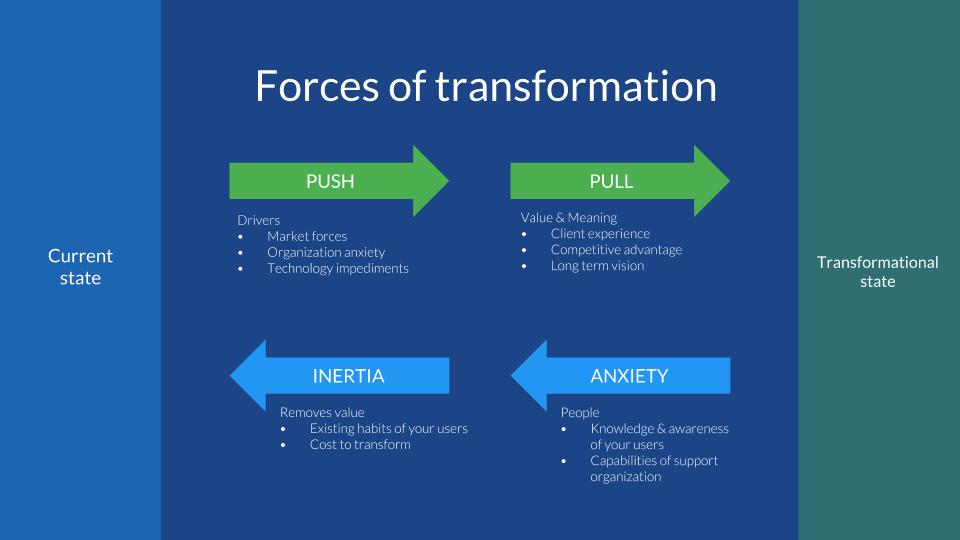
Seldomly are decisions made on a whim. Factors both internal and external guide these choices. Businesses are no different. Leaders are focused on constantly moving forward and embracing new strategies and technologies. Business leaders who do not adopt this approach, their business will stop moving forward, stay stagnant and the competitors will surpass them through their continual improvement and embracing constant change. One of the areas of transformation that leaders should be looking at is advisor marketing. Let’s explore the driving forces that are transforming advisor marketing.
To better examine the driving forces of transformation, we are looking at the “Jobs to Be Done” framework that we use internally to help with strategic planning. The 4 aspects of the framework are:
• Push: The problems that exist in the current state that drive the desire for charge.
• Pull: The benefits that a company would get from making the change and transforming to the new state
• Inertia: These are the costs and habits that are holding back from making the change
• Anxiety: There are the concerns people and groups have about moving the known to the unknown transformational state.

Push:
As mentioned previously, companies are always trying to move forward because in many cases the stagnant organizations will be surpassed. This competition forces companies to adapt and continue to transform. The second factor that pushes organizations towards transformation is organizational anxiety. People are always changing, learning to do new things, and improving old things. This applies to advisor marketing transformation. There may have been a way to do things in the past, advisors are more knowledgeable and become less content with the current state for advisor marketing that they demand better. The final factor that pushes for transformation is technology impediments. Legacy systems may have been a solution when first implemented but as marketing best practices evolve, so should the advisor marketing platform. If the platform does not evolve, SEO rankings will drop, brand perception will decrease, user experience will be outdated, etc.
Pull:
There are also factors that pull organizations toward the transformational state. These are not obligations (at the moment) but instead factors that would provide value and meaning to users. The first is Client Experience. There has been a lot of disruptions we see across many industries. These disruptions change the way organizations and clients interact, resulting in clients wanting exceptional experiences regardless of industry or organization. The second factor is competitive advantage. The transformation would be perceived as an extra to differentiate from other organizations; allowing for more sales or different pricing/positioning models. The last factor is long-term vision. The leadership of the organizations may see external factors and predict future changes and are deciding to be proactive instead of reactive by implementing a transformational program.
If the platform does not evolve, SEO rankings will drop, brand perception will decrease, user experience will be outdated, etc.
Inertia:
Simply these are the factors that hold organizations back from making change to “what has always been done.” First is the existing habits of users. Transformation may be too much of a radical change for people and can result in poor user adoption/user frustration in the beginning. Secondly, whether it is human or monetary resources, there is a cost to the transformation that is weighed against the benefits. Often times, the cost is seen as too high without being able to truly see the value.
Anxiety:
There are human factors that question the value of the transformation. Are the users aware of the need/desire for change, and do they have to the knowledge to adapt to the transformation? Are the decision makers willing to take the risk involved with transformation? Additionally, does the organization have the capabilities to support the transformational platform and its users before, during, and after its implementation?
When wondering if your organization should move from its current advisor marketing program to a transformational state, it is important to properly evaluate the driving forces behind the transformation. Using the “Jobs to Be Done” framework, organization can see all the factors that are driving them towards the transformational program and all the factors that would restrict them from moving forward.











